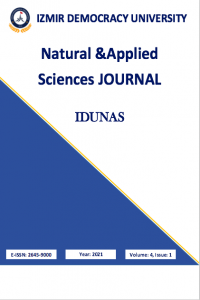Abstract
Wound healing assays are important for molecular biologists to understand the
mechanisms of cell migration. For the analysis of wound healing assays, accurate
segmentation of the wound front is a necessity. Manual annotation of the wound front is
inconvenient since it is time-consuming and annotator-dependent. Thus automated, fast,
and robust solutions are required. There are several image processing techniques
proposed to fulfill this need. However, requirement for specification of optimal
parameters, the need for human intervention, and the lack of high accuracy emerge as
the downfalls for most of them. In this study we have proposed a novel method to
overcome these difficulties.
Keywords
Image segmentation quantification wound healing assay collective cell migration phase-contrast microscopy
References
- Matsubayashi, Yutaka, William Razzell, and Paul Martin. "White wave’analysis of epithelial scratch wound healing reveals how cells mobilise back from the leading edge in a myosin-II-dependent fashion." Journal of cell science 124.7 (2011): 1017-1021.
- Gebäck, Tobias, et al. "TScratch: a novel and simple software tool for automated analysis of monolayer wound healing assays: Short Technical Reports." Biotechniques 46.4 (2009): 265-274.
- Suarez-Arnedo, Alejandra, et al. "An image J plugin for the high throughput image analysis of in vitro scratch wound healing assays." bioRxiv (2020).
- Zordan, Michael D., et al. "A high throughput, interactive imaging, bright‐field wound healing assay." Cytometry Part A 79.3 (2011): 227-232.
- Topman, Gil, Orna Sharabani-Yosef, and Amit Gefen. "A standardized objective method for continuously measuring the kinematics of cultures covering a mechanically damaged site." Medical engineering & physics 34.2 (2012): 225-232.
- Grada, Ayman, et al. "Research techniques made simple: analysis of collective cell migration using the wound healing assay." Journal of Investigative Dermatology 137.2 (2017): e11-e16.
- Huang, Kai, and Robert F. Murphy. "From quantitative microscopy to automated image understanding." Journal of biomedical optics 9.5 (2004): 893-913.
- Garcia, Fossa, Vladimir Fernanda Gaal, and B. de Jesus Marcelo. "PyScratch: an ease of use tool for analysis of Scratch assays." Computer Methods and Programs in Biomedicine (2020): 105476.
- Milde, Florian, et al. "Cell Image Velocimetry (CIV): boosting the automated quantification of cell migration in wound healing assays." Integrative Biology 4.11 (2012): 1437-1447.
- Wound healing image segmentation tool: http://dev.mri.cnrs.fr/projects/imagej-macros/wiki/Wound_Healing_Tool
- Mayalı, Berkay, et al. "Automated Analysis of Wound Healing Microscopy Image Series-A Preliminary Study." 2020 Medical Technologies Congress (TIPTEKNO). IEEE, 2020.
- Image annotation online tool: https://supervise.ly
Abstract
References
- Matsubayashi, Yutaka, William Razzell, and Paul Martin. "White wave’analysis of epithelial scratch wound healing reveals how cells mobilise back from the leading edge in a myosin-II-dependent fashion." Journal of cell science 124.7 (2011): 1017-1021.
- Gebäck, Tobias, et al. "TScratch: a novel and simple software tool for automated analysis of monolayer wound healing assays: Short Technical Reports." Biotechniques 46.4 (2009): 265-274.
- Suarez-Arnedo, Alejandra, et al. "An image J plugin for the high throughput image analysis of in vitro scratch wound healing assays." bioRxiv (2020).
- Zordan, Michael D., et al. "A high throughput, interactive imaging, bright‐field wound healing assay." Cytometry Part A 79.3 (2011): 227-232.
- Topman, Gil, Orna Sharabani-Yosef, and Amit Gefen. "A standardized objective method for continuously measuring the kinematics of cultures covering a mechanically damaged site." Medical engineering & physics 34.2 (2012): 225-232.
- Grada, Ayman, et al. "Research techniques made simple: analysis of collective cell migration using the wound healing assay." Journal of Investigative Dermatology 137.2 (2017): e11-e16.
- Huang, Kai, and Robert F. Murphy. "From quantitative microscopy to automated image understanding." Journal of biomedical optics 9.5 (2004): 893-913.
- Garcia, Fossa, Vladimir Fernanda Gaal, and B. de Jesus Marcelo. "PyScratch: an ease of use tool for analysis of Scratch assays." Computer Methods and Programs in Biomedicine (2020): 105476.
- Milde, Florian, et al. "Cell Image Velocimetry (CIV): boosting the automated quantification of cell migration in wound healing assays." Integrative Biology 4.11 (2012): 1437-1447.
- Wound healing image segmentation tool: http://dev.mri.cnrs.fr/projects/imagej-macros/wiki/Wound_Healing_Tool
- Mayalı, Berkay, et al. "Automated Analysis of Wound Healing Microscopy Image Series-A Preliminary Study." 2020 Medical Technologies Congress (TIPTEKNO). IEEE, 2020.
- Image annotation online tool: https://supervise.ly
Details
| Primary Language | English |
|---|---|
| Subjects | Engineering, Computer Software, Electrical Engineering |
| Journal Section | Articles |
| Authors | |
| Publication Date | June 30, 2021 |
| Acceptance Date | April 5, 2021 |
| Published in Issue | Year 2021 Volume: 4 Issue: 1 |

